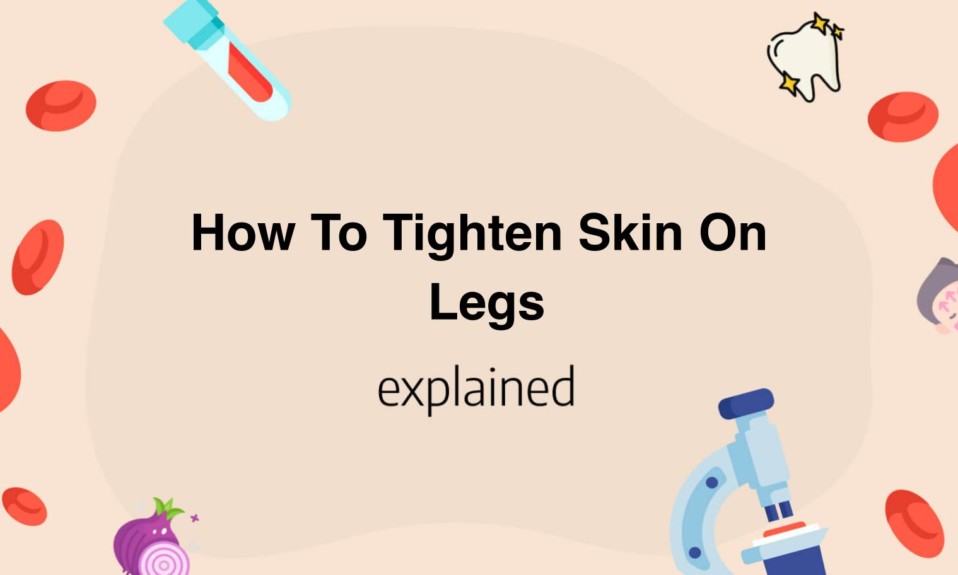Are you looking for ways to tighten your skin on your legs and regain a smoother, youthful appearance? If so, you’re in the right place.
In this guide, we will explore effective techniques and helpful tips to improve the elasticity and firmness of your leg skin.
Whether you’re dealing with sagging skin due to age, weight loss, or other factors, our expert advice will provide you with the insight you need to achieve the desired results.
Explore our tips below and get ready to enjoy tighter, more toned legs once again.
- Exercise regularly to tone the muscles in your legs.
- Incorporate strength training exercises into your workout routine to build muscle and improve skin elasticity.
- Eat a balanced diet rich in vitamins and minerals to nourish your skin from within.
- Stay hydrated by drinking plenty of water to promote skin elasticity and firmness.
- Use topical creams or lotions containing ingredients like retinol, collagen, or hyaluronic acid to tighten and moisturize the skin on your legs.
The Importance of Skin Firmness and Tightness for Legs
Skin firmness and tightness are crucial aspects of maintaining healthy, attractive legs.
As we age, the skin on our legs tends to lose its elasticity, resulting in sagging and the formation of cellulite.
This not only affects our physical appearance but can also impact our self-confidence.
Therefore, it is important to understand the significance of maintaining skin firmness and tightness for our legs.
One of the main reasons why skin firmness and tightness are important for our legs is their role in supporting the underlying muscles and tissues.
Firm skin provides a strong foundation for these structures, helping to maintain their proper alignment and function.
On the other hand, if the skin is loose and sagging, it can lead to muscle weakness and imbalances, making activities such as walking or running more difficult.
Additionally, poor skin elasticity can contribute to the development of varicose veins, which can cause discomfort and further compromise leg health.
Another reason for prioritizing skin firmness and tightness is the prevention of cellulite.
Cellulite occurs when fat deposits push through the connective tissues, resulting in the characteristic dimpled appearance on the skin.
While it can affect individuals of all body types, maintaining firm skin can help minimize its visibility.
By promoting collagen production, which improves skin elasticity, one can reduce the appearance of cellulite on the legs.
For instance, regularly massaging the legs or using specialized creams can stimulate blood flow and promote the breakdown of fat deposits, leading to smoother skin.
Additionally, having firm and tight skin on the legs contributes to a more youthful and toned overall appearance.
Whether we are wearing shorts, skirts, or swimsuits, having firm skin instills confidence and is visually appealing.
Taking care of our legs by moisturizing regularly, exfoliating to remove dead skin cells, and maintaining a healthy lifestyle can all contribute to improved skin firmness and tightness.
In conclusion, maintaining skin firmness and tightness in the legs is vital for both physical and mental well-being.
Not only does it provide support for the underlying muscles and tissues, but it also helps prevent the formation of cellulite and promotes a more youthful appearance.
By implementing proper skincare routines and adopting healthy lifestyle habits, we can ensure that our legs remain firm and attractive.
Remember, healthy skin is a reflection of overall health, so let’s prioritize the firmness and tightness of our legs for a confident stride through life.
Understanding the Causes of Loose Skin on Legs
Loose skin on the legs is a common concern for many individuals, especially as they age or undergo significant weight loss.
There are several factors that contribute to the development of loose skin on the legs, and understanding these causes can help individuals better manage and prevent this issue.
One of the primary causes of loose skin on the legs is a decrease in the production of collagen and elastin fibers.
These fibers are responsible for maintaining the skin’s elasticity and structure.
As we age, the production of these fibers naturally declines, leading to a loss of firmness and elasticity in the skin.
Additionally, factors such as sun exposure, smoking, and poor nutrition can further accelerate this process.
Another contributing factor to loose skin on the legs is rapid weight loss or fluctuations in weight.
When individuals lose a significant amount of weight, the skin may not have enough time to adapt to the body’s new shape.
As a result, it may appear loose and saggy.
This is especially common in cases where individuals have lost a large amount of weight in a short period of time.
Additionally, genetics can play a role in the development of loose skin on the legs.
Some individuals may be predisposed to having less elastic skin due to their genetic makeup.
While genetics cannot be changed, adopting a healthy lifestyle can help minimize the appearance of loose skin.
To prevent and manage loose skin on the legs, there are several strategies that individuals can implement.
Firstly, maintaining a healthy diet rich in vitamins, minerals, and antioxidants can promote skin health and elasticity.
Drinking plenty of water and using moisturizers can also help improve skin hydration and prevent dryness, which can contribute to loose skin.
Regular exercise, particularly strength training exercises, can help tone the muscles in the legs and improve skin elasticity.
Building muscle can provide support to the skin and reduce the appearance of sagging.
Including exercises such as squats, lunges, and leg presses in your fitness routine can be beneficial.
In conclusion, loose skin on the legs can be caused by a decrease in collagen and elastin production, rapid weight loss, and genetic factors.
By adopting a healthy lifestyle, individuals can improve skin health and minimize the appearance of loose skin.
Regular exercise, a balanced diet, and proper hydration are key components in maintaining healthy skin on the legs.
Effective Home Remedies to Tighten Skin on Legs
There are several effective home remedies that can help tighten the skin on your legs.
One such remedy is exfoliation.
Regularly exfoliating your legs can help remove dead skin cells and promote the growth of new, healthier skin.
You can make a natural exfoliating scrub using ingredients like sugar, coffee grounds, or sea salt mixed with coconut oil or olive oil.
Gently massage the scrub onto your legs in circular motions, then rinse it off with warm water.
Another helpful remedy is hydration.
Keeping your skin hydrated is crucial for maintaining its elasticity.
Drink plenty of water throughout the day and moisturize your legs with a nourishing lotion or oil.
This helps to retain moisture and prevent dryness, which can contribute to sagging skin.
Additionally, exercise plays a vital role in tightening the skin on your legs.
Regular physical activity, such as jogging, cycling, or squats, can help tone the muscles and improve blood circulation, resulting in firmer skin.
Incorporating strength training exercises that target the legs, such as lunges or leg lifts, can be particularly beneficial.
Remember to start slowly and gradually increase the intensity of your workouts to avoid injury.
Incorporating foods that are rich in collagen into your diet can also contribute to tighter skin on your legs.
Collagen is a protein that helps maintain skin elasticity.
Foods like bone broth, fish, citrus fruits, berries, and leafy green vegetables contain nutrients that support collagen production.
Including these foods in your meals can have a positive impact on the overall health and appearance of your skin.
Lastly, massage can help tighten the skin on your legs.
Massaging your legs regularly improves blood circulation and stimulates the production of collagen and elastin, which are essential for skin elasticity.
You can use a moisturizing oil or lotion while massaging to nourish and hydrate the skin.
Use upward strokes and gentle pressure, focusing on areas where the skin feels looser.
Remember, achieving tighter skin on your legs takes time and consistency.
It is important to incorporate these remedies into your daily routine and be patient with the results.
By exfoliating, hydrating, exercising, consuming collagen-rich foods, and massaging regularly, you can promote skin tightening and achieve smoother and firmer legs.

Different Surgical Options for Tightening Skin on Legs
There are several surgical options available to tighten the skin on the legs, each with its own advantages and considerations.
Body contouring procedures are a popular choice for individuals who have lost a substantial amount of weight and are left with loose skin on their legs.
These procedures, such as a thigh lift or lower body lift, involve removing excess skin and tightening the remaining skin to create a more toned and youthful appearance.
Liposuction is another surgical option that can help tighten the skin on the legs.
This procedure involves removing excess fat deposits using a cannula, which can often lead to skin retraction and improved skin tightness.
However, liposuction alone may not be effective for individuals with significant skin laxity.
Another surgical option for skin tightening on the legs is skin excision.
This procedure involves removing excess skin and tightening the remaining skin to achieve the desired results.
Skin excision is often combined with liposuction to remove excess fat deposits and improve overall leg contour.
Radiofrequency skin tightening is a minimally invasive procedure that uses radiofrequency energy to heat the deeper layers of the skin, stimulating collagen production and tightening loose skin.
This procedure can be effective for mild to moderate skin laxity and may require multiple sessions for optimal results.
When considering surgical options for skin tightening on the legs, it is important to consult with a board-certified plastic surgeon who specializes in body contouring procedures.
The surgeon will assess your individual needs and goals, and recommend the most appropriate procedure for you.
It is also important to have realistic expectations about the outcomes of these procedures, as they can improve skin tightness but may not achieve perfection.
Recovery time and potential risks and complications should also be discussed during the consultation.
In conclusion, there are several surgical options available for tightening the skin on the legs.
These include body contouring procedures, liposuction, skin excision, and radiofrequency skin tightening.
Each procedure has its own advantages and considerations, and it is important to consult with a qualified surgeon to determine the most suitable option for your individual needs.
Remember, undergoing any surgical procedure is a personal decision and should be made after careful consideration and understanding of the potential risks and benefits.
You’ll also like: When Is It Safe To Let A Drunk Person Sleep
How To Tighten Skin On Legs
There are several effective ways to tighten the skin on your legs and improve their overall appearance.
One of the most important steps is to maintain a healthy lifestyle that includes a balanced diet and regular exercise.
Proper nutrition plays a vital role in skin health, so it’s important to consume foods that are rich in vitamins, minerals, and antioxidants.
These nutrients can help to improve collagen production and promote skin elasticity.
Additionally, regular exercise can help to tone the muscles underneath the skin, which can contribute to a tighter and firmer appearance.
Another method to tighten the skin on your legs is through the use of topical treatments.
There are various creams and lotions available on the market that are specifically formulated to improve skin elasticity and firmness.
Look for products that contain ingredients like retinol, collagen, or peptides, as these can help to stimulate collagen production and improve skin texture.
When applying these products, it’s important to massage them into the skin using upward strokes to encourage blood flow and promote absorption.
In addition to these methods, there are also non-invasive cosmetic procedures that can help to tighten the skin on your legs.
One popular option is radiofrequency skin tightening.
This treatment uses radiofrequency energy to heat the deep layers of the skin, which stimulates collagen production and tightens the skin.
Another option is laser therapy, which works by delivering concentrated light energy to the skin, promoting collagen production and improving skin elasticity.
These treatments are usually performed by trained professionals and may require multiple sessions for optimal results.
It’s important to note that while these methods can be effective, they may not provide instant or drastic results.
Consistency and patience are key when it comes to achieving tighter skin on your legs.
Additionally, it’s important to consult with a healthcare professional or dermatologist before starting any new skincare routine or undergoing cosmetic procedures.
In conclusion, tightening the skin on your legs can be achieved through various methods such as maintaining a healthy lifestyle, using topical treatments, and considering non-invasive cosmetic procedures.
Remember to stay consistent and patient, as results may take time to become noticeable.
By incorporating these strategies into your routine, you can improve the appearance of your legs and boost your confidence.
Read also: How To Sleep After Shoulder Surgery
Essential Nutrients and Supplements for Healthy Leg Skin
Healthy leg skin requires a combination of essential nutrients and supplements to maintain its optimal condition.
These nutrients help nourish the skin, promote collagen production, and protect against damage caused by environmental factors.
Incorporating these into your daily routine can make a significant difference in the overall health and appearance of your legs.
Vitamin C is an essential nutrient for healthy leg skin.
It plays a vital role in collagen synthesis, which is necessary for maintaining the skin’s elasticity and strength.
Citrus fruits, strawberries, and leafy green vegetables are excellent sources of vitamin C.
Incorporating these foods into your diet can help promote collagen production and improve the overall texture of your leg skin.
Another crucial nutrient for healthy leg skin is vitamin E.
This vitamin acts as a powerful antioxidant, protecting the skin cells from oxidative damage.
Nuts, seeds, and oils, such as sunflower and almond oil, are rich sources of vitamin E.
Regularly applying vitamin E oil or using products enriched with this vitamin can help keep your leg skin moisturized and protected from environmental stressors.
Omega-3 fatty acids are beneficial for maintaining the health of your leg skin.
These healthy fats have anti-inflammatory properties that can help reduce skin redness and irritation.
Cold-water fish like salmon and sardines, flaxseed, and chia seeds are excellent sources of omega-3 fatty acids.
Including these foods in your diet can help improve the overall texture and appearance of your leg skin.
In addition to essential nutrients, certain supplements can also support healthy leg skin.
Collagen supplements are popular for their potential to improve skin elasticity and hydration.
These supplements are available in various forms such as powders, capsules, and liquids.
When considering collagen supplements, it’s essential to choose high-quality ones from reputable brands.
Furthermore, incorporating antioxidant-rich supplements like green tea extract or grape seed extract can also help promote the health of your leg skin.
These supplements are known for their ability to neutralize free radicals and reduce oxidative stress, which can contribute to skin aging.
However, it’s important to consult with a healthcare professional before adding any supplements to your routine.
In conclusion, maintaining healthy leg skin requires a combination of essential nutrients and supplements.
Vitamins C and E, omega-3 fatty acids, collagen supplements, and antioxidant-rich supplements are all beneficial for promoting the overall health and appearance of your leg skin.
By incorporating these into your daily routine and maintaining a balanced diet, you can achieve healthy and radiant leg skin.
Read also:










